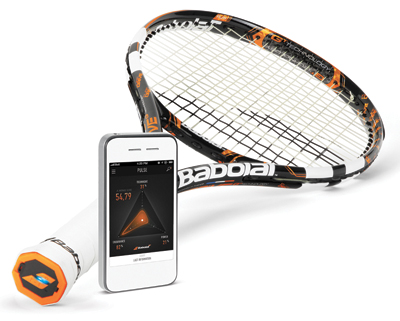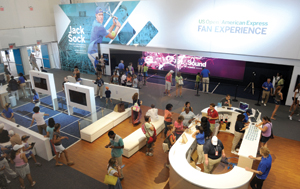Editor's note: This story is revised from the print edition.
In coming years, when a pro like Rafael Nadal is done with his match, he will sign autographs (as always), pack his bags and head to the locker room — where he may proceed to plug in his racket.
Yes, plug in his racket. Racket leader Babolat expects many of its top pros to begin playing in January with a racket that measures various performance data, such as ball impact speed, and comes with a USB port in the handle knob. The handle itself carries the technology that allows it to collect data from the vibrations of the ball hitting the strings.
Nadal has already practiced with the Babolat Play racket, which produces data that can be downloaded to mobile phones and computers via the USB port or Bluetooth technology. Babolat will own the rights to the performance data, said Eric Babolat, the fifth-generation CEO of the 138-year-old French company.
 |
The Babolat Play connects via USB, Bluetooth to smartphones.
Photo by: BABOLAT |
Nadal is the company’s most prominent spokesman, but he likely will not be the first to actually use the new racket on court because he plays with a different frame than what Babolat Play has. Babolat expects to quickly move the software into other frames, but for now, the players the CEO pointed to as being likely to take the racket on court were
Agnieszka Radwanska,
Li Na and
Fabio Fognini, who do play with Babolat Play’s Pure Drive frame.
“[This is like] movies going from silent to talking,” Babolat said of the technological advance.
The racket is slow-launching in the United States, with only a few thousand of them slated to be available in December in as-of-yet unchosen retailers. The price is $399, making it far and away the most expensive racket on the market. High-end rackets rarely top $250, Babolat said.
The company is now amassing about 300 players, coaches and recreational players in the United States to test the product over the next few months and, more importantly, to collect their performance data. The racket will show, for example, how powerfully a user can hit a shot compared with Nadal.
The International Tennis Federation last month, after months of lobbying from Babolat, approved the racket for play, but not until January. Players cannot download the information during play, only after or during a rain delay.
The tours and Grand Slams can use their own rules, though. The WTA, for example, allows coaching breaks, which are not allowed by the ITF rules of tennis, so it’s possible those coaching breaks could use Babolat Play data.
Tennis has been resistant to the “Moneyball” approach of other sports — players often mock even watching matches of prospective opponents — so whether Babolat Play and the new data take the pro tours by storm is certainly in question. Still, Babolat is planning some social media and traditional advertising in tennis outlets to promote the racket, as well as a March event at the BNP Paribas Open in California.
The U.S. launch of the product also is a first for Babolat, which has always launched rackets in Europe. The U.S. dominance of social media and acceptance of wired products persuaded the company to head to America first.
■ CALLING RAFA: Speaking of Nadal and Babolat: The Spaniard talked to three fans on the phone last Tuesday evening as part of a promotion. Babolat put a number to call on its Facebook page, and out of the thousands of calls that came in, three callers were randomly chosen to speak to Nadal.
■
AMEX ACTIVATION: The American Express Fan Experience is clearly the most trafficked on-site sponsor area at the Open.
AmEx is in its second year with the two-story, 20,000-square-foot exhibition space, situated near the east gate, where most fans enter the grounds. In 2012, it attracted 100,000 visitors, or about one in seven of the fans who attended the event. Michele Carr, director of sports
 |
The American Express Fan Experience, a two-story space covering 20,000 square feet, includes a digital board that allows fans to create art by swinging a racket.
Photo by: GETTY IMAGES FOR AMERICAN EXPRESS (2)
|
marketing and strategy at AmEx, said she hopes to top that figure this year.
The space offers full tennis courts for clinics for both kids and adults; Kinect tennis; swing lessons; and a space commemorating the 40th anniversary of the Billie Jean King-Bobby Riggs match. New this year is a 6-by-30-foot digital board, called Art & Sound. Fans create art by swinging a racket with sensors that feed the movement into the digital board. The finished product is then emailed to the participants.
Additionally, the swing lessons are now open to all visitors, not just AmEx cardholders.
Gone from last year are kiosks where fans could plan their day. Instead, AmEx has created an app called TrendCast that assembles the top U.S. Open trends of the day. Then, at 4 p.m. each day, AmEx hosts a show where these trends are discussed. The show is physically broadcast on the second-floor card-member area of the exhibition space and can be heard via USOpen.org.
AmEx worked with Momentum Worldwide on the Fan Experience and on-site activation, and with Digitas on the TrendCast app program.







